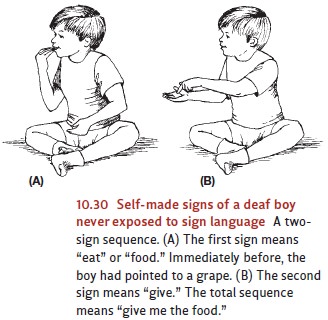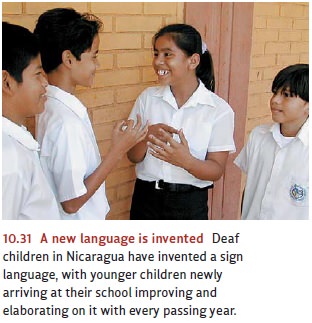Chapter: Psychology: Language
Language without a Model
Language
without a Model
What if children of normal
mentality were raised in a loving and supportive environ-ment but not exposed
to either speech or signed language? Researchers found six children who were in
exactly this sort of situation (Feldman, Goldin-Meadow, & Gleitman, 1978;
Goldin-Meadow, 2000; Goldin-Meadow & Feldman, 1977). These children were
deaf, so they were unable to learn spoken language. Their parents were hearing
and did not know ASL. They had decided not to allow their children to learn a
gestural language, because they shared the belief (held by some educators) that
deaf children should focus their efforts on learning spoken language through
special train-ing in lip-reading and vocalization. This training often proceeds
slowly and has limited success, so for some time these children did not have any
usable access to spoken English. Not yet able to read lips, unable to hear, and
without exposure to a gestural language, these children were essentially
without any linguistic stimulation.
These language-isolated children
soon did something remarkable: They invented a language of their own. For a
start, the children invented a sizable number of gestures that were easily
understood by others. For example, they would flutter their fingers in a
downward motion to express snow, twist their fingers to express a twist-top
bottle,

and so on (Figure 10.30;
Goldin-Meadow, 2003). This spontaneously devel-oping communication system
showed many parallels to ordinary language learning. The children began to
gesture one sign at a time at approximately the same age that hearing children
begin to speak one word at a time, and they progressed to more complex
sentences in the next year or so. In these basic sentences, the deaf children
placed the individual gestures in a fixed serial order, according to semantic
role—again, just as hearing children do.
More recent evidence has shown
just how far deaf children can go in inventing a language if they are placed
into a social environment that favors their communicating with each other. In
Nicaragua until the early 1980s, (A)
deaf children from rural areas were widely scattered and usually knew no others
who were deaf. Based on the findings just mentioned, it was not surprising to
discover that all these deaf individuals developed homemade gestural systems
(“home signs”) to communicate with the hearing people around them, each system
varying from the others in an idiosyncratic way. But then a school was created
just for such deaf chil-dren in Nicaragua, and since then they have been bused
daily from all over the coun-tryside to attend it. Just as in the American and
many European cases, the school authorities have tried to teach these children
to lip-read and vocalize. But on the bus and in the lunchroom, and literally
behind the teachers’ backs, these children (age 4 to 14 in the initial group)
began to gesture to each other. Bit by bit their idiosyncratic home signs
converged on conventions that they all used, and the system grew more and more
elaborate (Figure 10.31; Senghas, Román, & Mavillapalli, 2006). The
emerging gestural language of this school has now been observed over three
genera-tions of youngsters, as new 4-year-olds arrive at the school every year.
These new members not only learn the system but also elaborate and improve on
it, with the effect that in the space of 30 years a language system of
considerable complexity and semantic sophistication has been invented and put
to communicative use by these children (Kegl, Senghas, & Coppola, 1999;
Senghas, Kita, and Özyürek, 2004). Perhaps it is true that Rome was not built
in a day, but for all we know, maybe Latin was! In sum, if children are denied
access to a human language, they go to the trou-ble to invent one for
themselves.

Related Topics